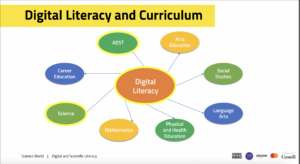Digital literacy makes up multiple different things. Technology and working digitally have become common but people have varying degrees of digital literacy. For some people digital literacy may just be being able to get on the internet and for others they are much more proficient. Digital literacy is something that is being taught more and incorporated into schools and curriculum. When I was in elementary and high school there were not really any digital literacy skills being taught or courses focused around them specifically. The most I had was keyboarding 9 or making a PowerPoint or Prezi presentation (I forget the name of the class). These courses were optional though, so not everyone actually took them. The Ministry of Education and Child Care defines digital literacy as “the interest, attitude, and ability of individuals to appropriately use digital technology and communication tools to access, manage, integrate, analyze and evaluate information, construct new knowledge, create and communicate with others” (Province of British Columbia, n.d.).
There are 6 characteristics of digital literacy for students to learn throughout their education. These characteristics are research and information literacy, critical thinking, problem solving, and decision making, creativity and innovation, digital citizenship, communication and collaboration, and technology operations and concepts. Each of these is broken down into grade appropriate learning activities for the students to explore digital literacy. Teachers can connect the cross-curricular competencies with the matching digital literacy characteristics and there is a “set of profiles that provide examples of activities that digitally literate students should be able to do at key developmental points in their K-12 education” (Province of British Columbia, n.d.).
The presentation from Science World enhanced my view on digital literacy as well as AI. Digital literacy is in the curriculum and it can be tied to any subject in schools. One of the takeaways I got from this presentation is how we can teach students digital literacy in order to develop useful skills for the world. An example is the activity we did where we quickly researched an outrageous scientific claim to see how many things we could find claiming it to be true. Incorporating activities like this in our classes will teach them life skills that can be used in school and beyond into different jobs. Digital literacy will be big part of people’s lives so it is important for students to learn about it and know how to navigate things online properly and safely. Having organizations like Science World come in and present helps show the real applications of digital literacy.

Digital literacy matters to me as a teacher and learner because I need to be able to engage students with the digital literacy framework. It is becoming increasingly more important to know these skills because technology is used everywhere. I need to be able to teach these digital literacy skills in a meaningful way. It is important to me as a learner as well because I was not taught digital literacy skills in school very often. Because of that, I am still continuously learning about them and getting better at using them in my life. I’m sure some of my future students will be able to teach me about digital literacy which will result in a reciprocal relationship of learning together.
References:
Province of British Columbia. (n.d.). Digital Literacy. Resources for Teachers: Digital Literacy. https://www2.gov.bc.ca/gov/content/education-training/k-12/teach/resources-for-teachers/digital-literacy